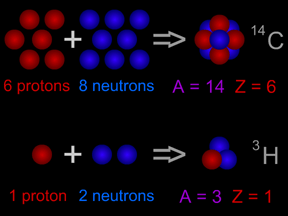The periodic table of the elements.
Click on image for full size
L.Gardiner/Windows to the Universe
The Periodic Table of the Elements
Everything you see around you is made of tiny particles called atoms. There are many different types of atoms, each with a special combination of protons
, neutrons
and electrons
. These different types of atoms are called elements.
To understand and remember all the different types of elements, scientists organized them all into a table called the periodic table of the elements. The picture on the left shows the table, which lists all the elements that have been found or created.
Each element has its own symbol. For instance, the upper left square of the table is labeled ‘H’. The ‘H’ is the symbol for an element called hydrogen.
Notice how each element in the table has its own number. This number is called the atomic number and tells us how many protons are in the nucleus of an atom of the element. For instance, each atom of hydrogen has one proton so there is a number one in hydrogen’s square.
Only the first 92 elements in the table are naturally found, while the others are synthetically made in places like laboratories. These elements are the ingredients used to make everything we find on Earth.
Last modified April 29, 2003 by Lisa Gardiner.
You might also be interested in:

An element (also called a "chemical element") is a substance made up entirely of atoms having the same atomic number; that is, all of the atoms have the same number of protons. Hydrogen, helium, oxygen,
...more
The nucleus of an atom has protons and neutrons in it. Each element (like carbon or oxygen or gold) has a different number of protons in its atoms. Scientists have a special name for the number of protons
...more
Chemistry is the study of matter, energy, and their interactions. Chemists study the composition of substances, their properties, and how they react with each other under varying circumstances. Indeed,
...more
Quartz is one of the most common mineral in Earth’s crust! Silica (Si) and Oxygen (O) are the only elements within pure quartz. If a cooling magma has silica leftover after feldspars form, quartz is likely
...more
Minerals are the building blocks of rocks. They are non-living, solid, and, like all matter, are made of atoms of elements. There are many different types of minerals and each type is made of particular
...more
Even though there are 92 elements that are naturally found, only eight of them are common in the rocks that make up the Earth’s outer layer, the crust. Together, these 8 elements make up more than 98%
...more
Many kilometers below the Earth’s surface, molten rock called magma flows into cracks or underground chambers. There, the magma sits, cooling very slowly over thousands to millions of years. As it cools,
...more













